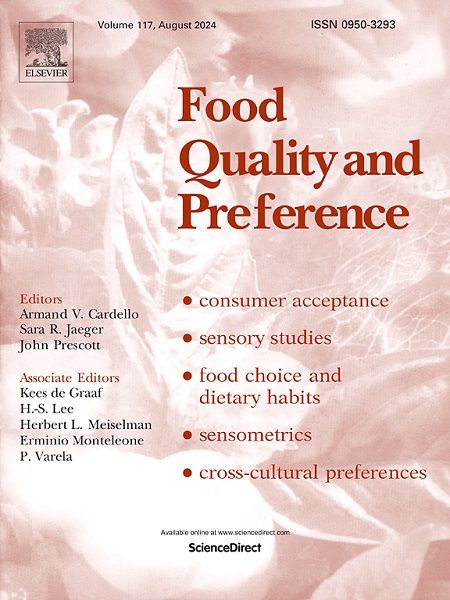Sensory and emotional perception of nitrite-free and meatless cooked ham alternatives; does information matter?
IF 4.9
1区 农林科学
Q1 FOOD SCIENCE & TECHNOLOGY
引用次数: 0
Abstract
The processed meat market is undergoing significant changes following the European Commission setting new reduced limits for the use of nitrites as food additives and the global shift toward meatless diets to improve human and planetary health. This study aimed to generate new consumer insights into the overall liking, sensory (CATA) and emotional (EsSense25 CATA) perception, and purchase intent of conventional, nitrite-free, and meatless cooked hams, and to understand whether the provision of health risk, health benefit, and health plus environmental benefit information can influence consumer responses to these products, respectively. Irish consumers (n = 120) evaluated each of the cooked hams twice without (blind) or with (informed) relevant information in a central location test. Results showed that regardless of experimental condition, the nitrite-free cooked ham was liked the most while the meatless product was liked the least. The provision of health benefit information significantly increased the overall liking and purchase intent of the nitrite-free product, while health plus environmental benefit information increased purchase intent of the meatless product. Following the provision of information, the conventional product was characterized by a significantly higher citation of “highly salty” while the meatless product had a significantly lower citation of “cooked ham flavour”. Moreover, for the nitrite-free product consumers cited significantly more “happy” and less “disgusted” emotional associations after the provision of information. The findings support innovation for the development of cooked hams that offer benefit in terms of health and the environment, driving opportunities for future consumer engagement within the processed meat industry.
无亚硝酸盐和无肉熟火腿替代品的感官和情感感知信息重要吗?
随着欧盟委员会对亚硝酸盐作为食品添加剂的使用制定了新的降低限制,以及全球向无肉饮食的转变,以改善人类和地球的健康,加工肉类市场正在发生重大变化。本研究旨在提供消费者对传统、无亚硝酸盐和无肉熟食的整体喜好、感官(CATA)和情感(EsSense25 CATA)感知和购买意愿的新见解,并了解提供健康风险、健康益处和健康加环境益处信息是否会分别影响消费者对这些产品的反应。爱尔兰消费者(n = 120)在中心位置测试中对每只煮熟的火腿进行两次评估,没有(盲)或有(知情)相关信息。结果表明,无论在何种实验条件下,人们对无亚硝酸盐熟火腿的喜爱程度最高,对无肉产品的喜爱程度最低。健康效益信息的提供显著增加了对无亚硝酸盐产品的整体喜爱和购买意愿,而健康加环境效益信息增加了对无肉产品的购买意愿。在提供信息后,传统产品的特点是“高盐”的引用明显较高,而无肉产品的“熟火腿味”的引用明显较低。此外,对于不含亚硝酸盐的产品,消费者在提供信息后明显更多地引用了“快乐”和“厌恶”的情感联系。研究结果支持了对健康和环境有益的熟火腿开发的创新,为未来消费者参与加工肉类行业创造了机会。
本文章由计算机程序翻译,如有差异,请以英文原文为准。
求助全文
约1分钟内获得全文
求助全文
来源期刊

Food Quality and Preference
工程技术-食品科技
CiteScore
10.40
自引率
15.10%
发文量
263
审稿时长
38 days
期刊介绍:
Food Quality and Preference is a journal devoted to sensory, consumer and behavioural research in food and non-food products. It publishes original research, critical reviews, and short communications in sensory and consumer science, and sensometrics. In addition, the journal publishes special invited issues on important timely topics and from relevant conferences. These are aimed at bridging the gap between research and application, bringing together authors and readers in consumer and market research, sensory science, sensometrics and sensory evaluation, nutrition and food choice, as well as food research, product development and sensory quality assurance. Submissions to Food Quality and Preference are limited to papers that include some form of human measurement; papers that are limited to physical/chemical measures or the routine application of sensory, consumer or econometric analysis will not be considered unless they specifically make a novel scientific contribution in line with the journal''s coverage as outlined below.
 求助内容:
求助内容: 应助结果提醒方式:
应助结果提醒方式:


